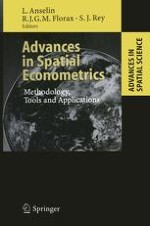The volume on New Directions in Spatial Econometrics appeared in 1995 as one of the first in the then new Springer series on Advances in Spatial Sciences. It very quickly became evident that the book satisfied a pent up demand for a collection of advanced papers dealing with the methodology and application of spatial economet rics. This emerging subfield of applied econometrics focuses on the incorporation of location and spatial interaction in the specification, estimation and diagnostic testing of regression models. The current effort is a follow up to the New Directions volume. Even though the number of empirical and theoretical journal articles dealing with various as pects of spatial econometrics has grown tremendously in the recent past, the need remained to bring together an advanced collection on methodology, tools and appli cations. This volume contains several papers that were presented at special sessions on spatial econometrics organized as part of a number of conferences of the Re gional Science Association International. In addition, a few papers were invited for submission. All papers were refereed. The focus in the volume reflects the advances made in the field in recent years.
